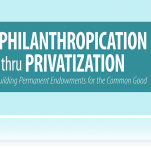Philanthropication thru Privatization
The Concept
A crucial barrier to the development of community-based philanthropic institutions in less-developed regions of the world has been the general lack of capital to underwrite their operations. Such institutions are a key element of building a strong, sustainable, civil society sector, which, in turn, is critical for enabling locally-led development and supporting the implementation of Official Development Assistance programs. One promising route to solving this dilemma may be to channel into charitable endowments all or a portion of the proceeds of a wide array of "privatization transactions" in which public assets are transferred into private hands or otherwise transformed. This process was identified by Dr. Lester M. Salamon of the Johns Hopkins Center for Civil Society Studies, who coined it as “Philanthropication thru Privatization” or “PtP.”
PtP be defined as a transaction in which all or a portion of the proceeds resulting from the sale or other transformation of public or quasi-public assets are dedicated to the creation or expansion of charitable endowments under the control of meaningfully autonomous private charitable institutions. PtP is not just an abstract idea. Indeed, some of the largest and most reputable foundations in the world, such as Germany's Volkswagen Foundation, Italy's foundations of banking origin, New Zealand's network of "community trusts," Belgium's King Baudouin Foundation, Spain's massive "la Caixa" Banking Foundation (the 3rd largest foundation in the world), and the Truth Initiative and over 200 health conversion foundations in the U.S. have all resulted from, or been enlarged through, a PtP process. To date, nine identifiable asset classes have been involved in such transactions, including: 1) state-owned enterprises; 2) other state-owned property; 3) debt swaps; 4) royalties from state-regulated businesses; 5) transformations of nonprofits or mutuals; 6) stolen assets; 7) stranded assets; 8) penalties arising from corporate misdeeds; and 9) broadcast spectrum auctions.
The PtP Initiative
With a start-up grant from the Charles Stewart Mott Foundation, EWMI launched the PtP Initiative in 2008 to explore and promote the PtP option. The PtP Initiative is the first concerted effort to pursue this option for creating indigenous charitable endowments out of the proceeds of privatization transactions and has received support from the Charles Stewart Mott, Volkswagen, King Baudouin, la Caixa, and Ford foundations, as well as from a coalition of eight Italian foundations of banking origin. The project was founded by Dr. Salamon and was directed by him until his passing in August 2021. Dr. Salamon was assisted by a robust international team of Project Associates; an Advisory Committee chaired by Dr. Wilhelm Krull, General Secretary of the Volkswagen Foundation; and a network of PtP Exploratory Committees operating in different regions of the world, many of whom remain involved in the project.
To date, the Initiative has identified 643 PtP foundations holding over US$201 billion in assets and conducted detailed case studies of several of these foundations, resulting in a major report, Philanthropication thru Privatization: Building Permanent Endowments for the Common Good, which analyzes how these foundations came about and how they have performed. The Initiative has also convened two major PtP international conferences and developed several "How-to" Booklets designed to acquaint citizens with how to apply the PtP approach to various asset classes in which it has surfaced and how to ensure that the resulting foundations adhere to international best practices of transparency, accountability, and community engagement.
From Theory to Implementation
The EWMI PtP team is now providing technical assistance to two major efforts to implement the PtP approach, including:
- Airwaves for Equity (United States): Spearheaded by New America’s Open Technology Institute, the Airwaves For Equity Coalition—which also includes the American Library Association, the Benton Institute for Broadband and Society, Center for Rural Strategies, Common Sense Media, Consumer Reports, National Digital Inclusion Alliance, Public Knowledge and Schools, and the Health & Libraries Broadband (SHLB) Coalition—is working to enhance digital literacy and adoption in the U.S. by creating a Digital Equity Foundation funded by the proceeds from wireless spectrum auctions. With support from the Ford Foundation, the PtP team has contributed to the development of two major papers laying out the case for the capture of spectrum auction proceeds in the form of a Digital Equity Foundation and providing detailed guidance on how the resulting foundation should be structured to ensure that is both effective and responsive in its operations and governance. The Digital Equity Foundation Act, taking on board these recommendations, was reintroduced in the 2023 session of the United States Congress by U.S. Senators Ben Ray Luján (D-N.M.), Dianne Feinstein (D-Calif.), Amy Klobuchar (D-Minn.), Richard Blumenthal (D-Conn.), Martin Heinrich (D-N.M.), Ed Markey (D-Mass.), Jeff Merkley (D-Ore.), and Dick Durbin (D-Ill.), and U.S. Representative Doris Matsui (D-Calif.).
- Nigerian Endowments through Asset Transformation (NEAT) Initiative (Nigeria): In close partnership with the African Network for Environment & Economic Justice (ANEEJ), EWMI PtP staff have launched a broad implementation effort in Nigeria, focusing on three key asset classes: 1) extractive industry proceeds; 2) debt-swaps; and 3) recovered stolen assets. The NEAT Initiative will carry out research, education, and advocacy to capture a portion of funds from upcoming and potential deals and legislative changes involving the three asset classes to endow at least one independent, private foundation to support local CSOs and communities working to address the pressing social and economic issues facing the people of Nigeria. The NEAT Initiative will adhere to the underpinning PtP principles of ensuring community and stakeholder input into the mission, focus, activities, and structure of any resulting foundation or institution, and will encourage a clear connection between the asset being captured—and any ills brought about by the activities underlying it—and the work carried out by the resulting foundation.















